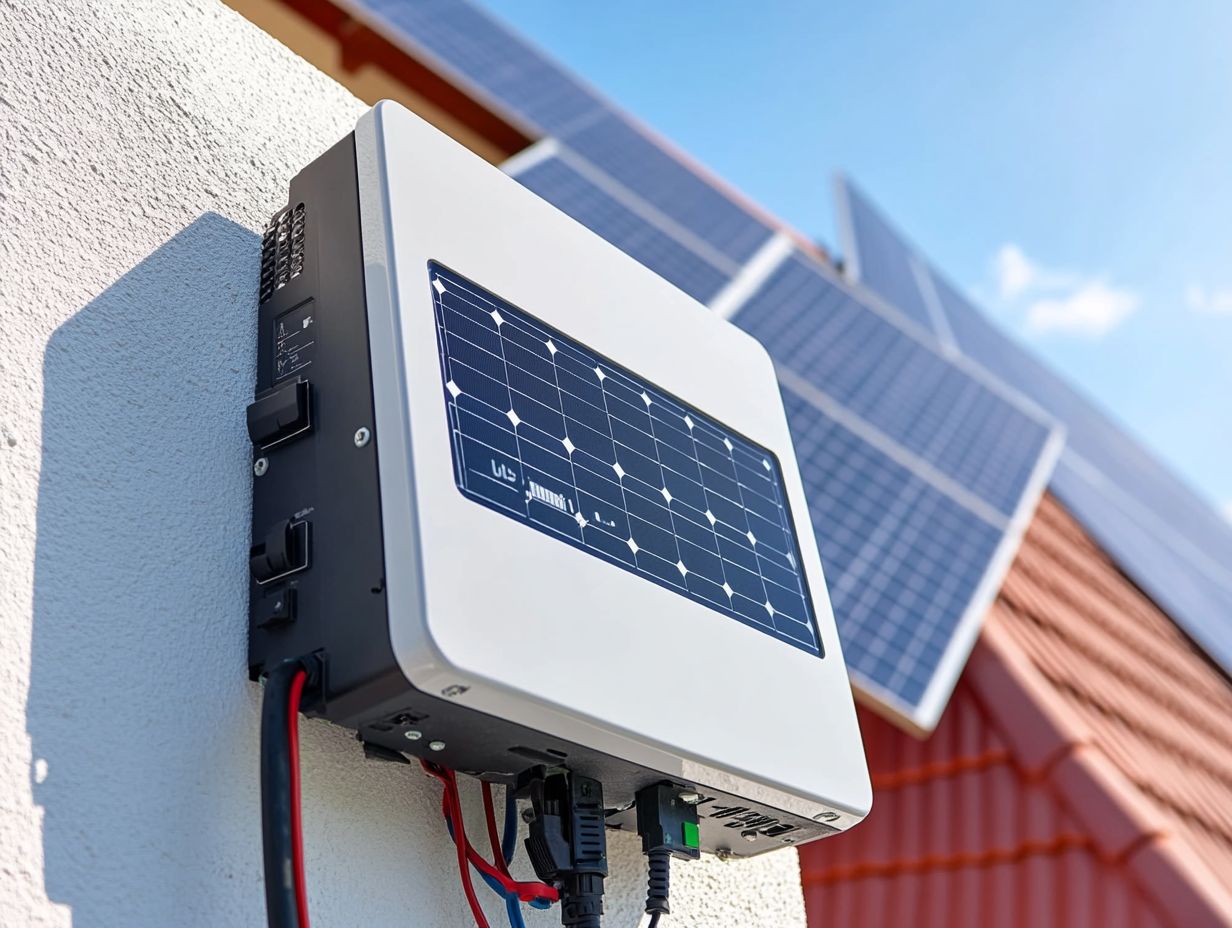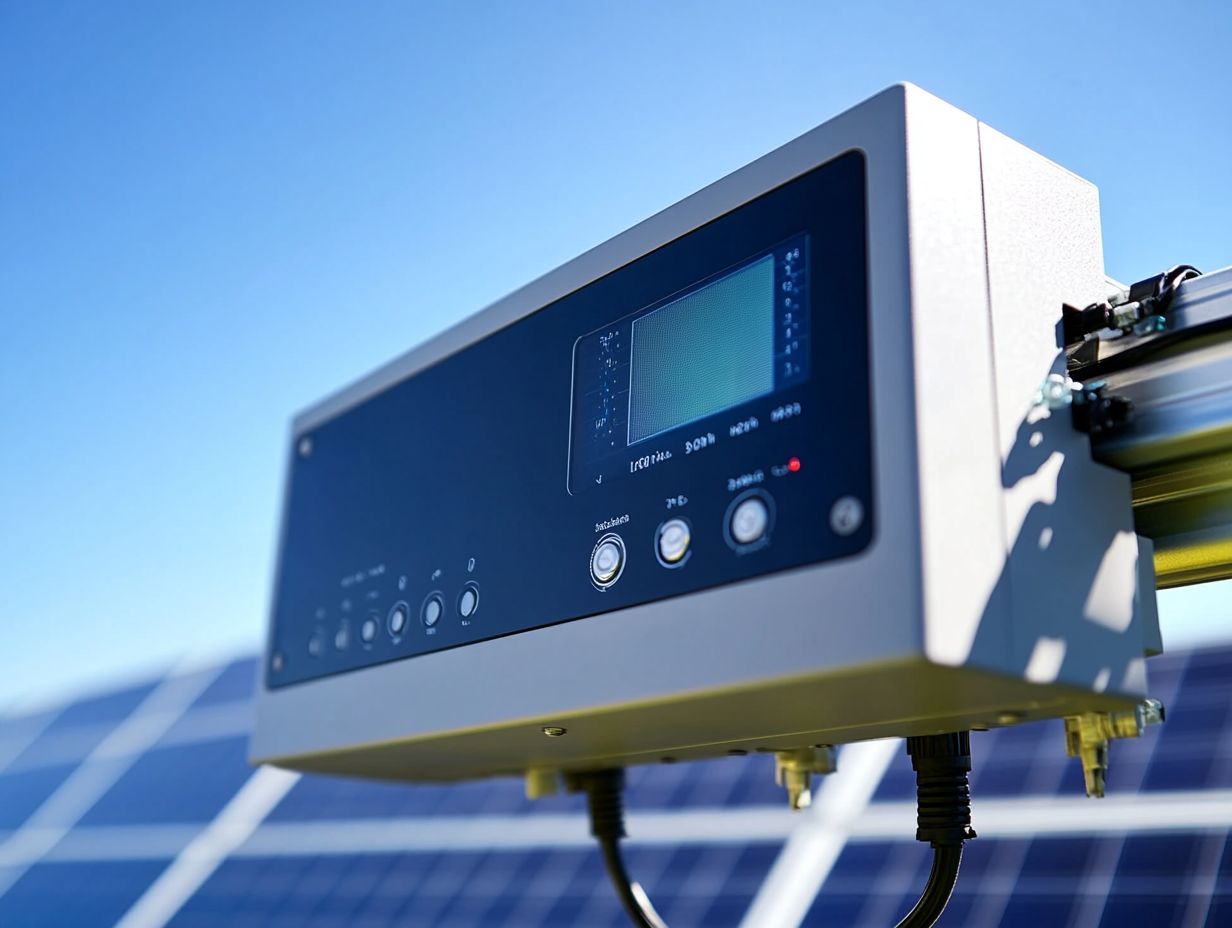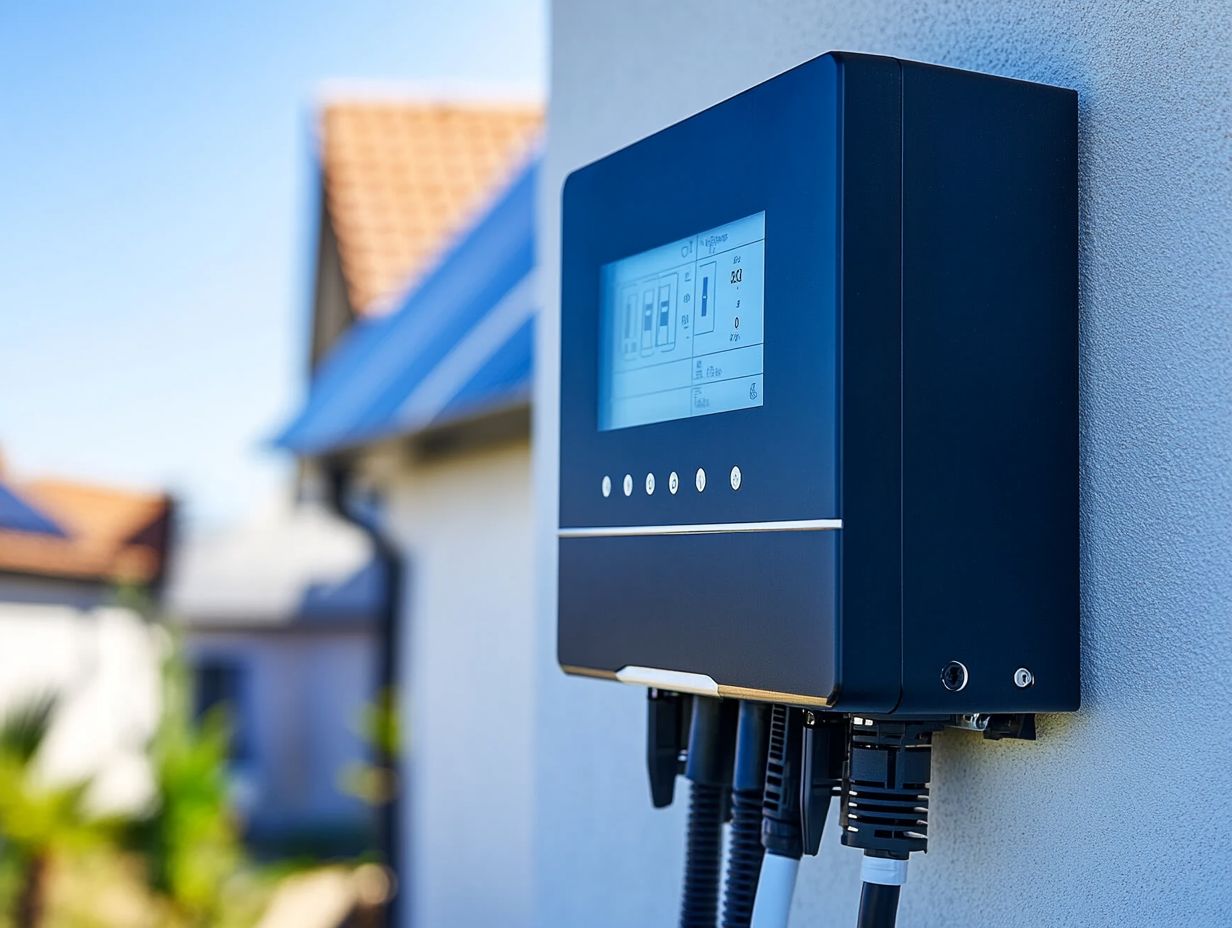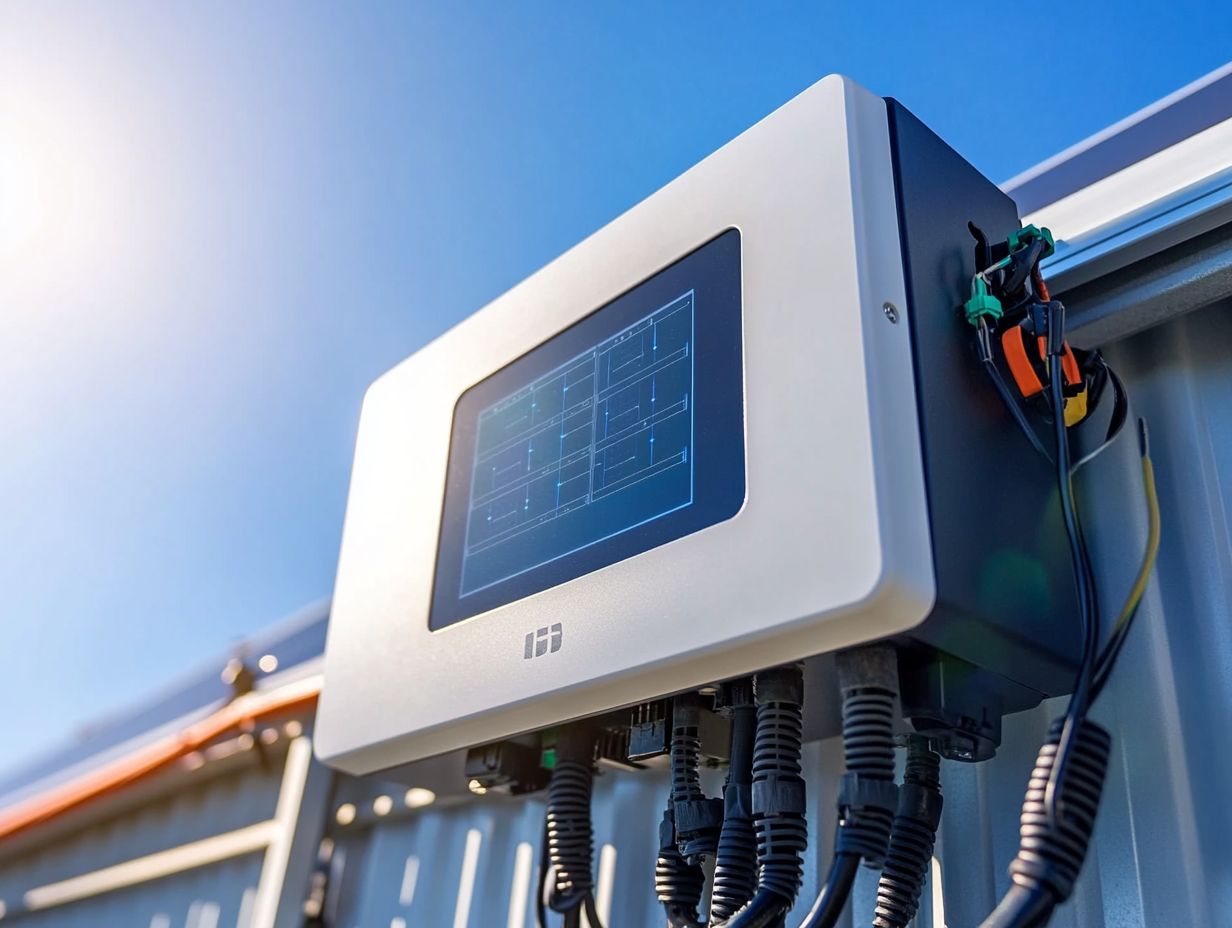Contents
- 1 Different Types of Solar Inverters
- 2 How Solar Inverters Work
- 3 Benefits of Using a Solar Inverter
- 4 Factors to Consider When Choosing a Solar Inverter
- 5 Frequently Asked Questions
- 5.1 What is a Solar Inverter?
- 5.2 How does a Solar Inverter work?
- 5.3 What are the different types of Solar Inverters and their features?
- 5.4 What are the benefits of using a Solar Inverter in terms of energy autonomy and electrical load management?
- 5.5 What factors should I consider when choosing a Solar Inverter?
- 5.6 Is a Solar Inverter necessary for my solar energy system?
Solar energy is becoming one of the top sources of renewable energy, providing you with a sustainable alternative to traditional energy sources and reducing your carbon footprint.
At the core of harnessing this energy are solar inverters, which are crucial devices that facilitate the DC to AC conversion process, turning sunlight into usable electricity through advanced inverter technology.
This piece dives into the different types of solar inverters, including micro inverters and string inverters, explaining how they work through a detailed energy conversion process, as well as the many advantages they offer for you as a homeowner and for environmental sustainability.
You’ll also find key factors to consider when choosing the right solar inverter to meet your needs.
Explore the transformative power of solar energy and the inverter technology driving it all, and consider how solar panels and photovoltaic systems contribute to renewable resource utilization.
Understanding Solar Energy and Its Conversion Process

Solar energy is a fantastic renewable resource you can harness from the sun. It gets transformed into usable electricity through photovoltaic technology, which means it captures sunlight and converts it into direct current (DC) electricity. Then, that DC has to be switched to alternating current (AC) for your home and the grid.
Understanding how this solar energy conversion works is key to getting the best out of your solar panel system, aiding in energy independence and optimizing system performance for a more sustainable lifestyle.
At its core, solar energy starts with photovoltaic cells that do an amazing job of catching sunlight and turning it into electricity using something called the photovoltaic effect. Once that sunlight is transformed into DC electricity, you’ll need inverter technology to switch it over to AC, making it ready for your household appliances and even sending some back into the grid.
This conversion process is super important because it affects how efficiently your solar energy system operates. Getting this right not only helps you maximize your energy output but also keeps your environmental footprint in check.
By adopting solar energy, you reduce reliance on fossil fuels; you’re also making a big dent in greenhouse gas emissions, paving the way for a cleaner and more sustainable future for everyone.
Kjaer, S. B., Pedersen, J. K., & Blaabjerg, F. (2005). A review of single-phase grid-connected inverters for photovoltaic modules. IEEE Transactions on Industry Applications, 41(5), 1292-1306. Link
Different Types of Solar Inverters
Solar inverters are crucial parts of solar energy systems; they serve as the link between your solar panels and the electrical grid.
You’ll come across different types of solar inverters, like micro-inverters, string inverters, and central inverters, each tailored for specific applications and efficiency levels, impacting the power output and electricity generation of your solar energy system.
Getting to know these inverter types is essential for making smart choices about your solar installation, helping you ensure optimal performance and compatibility with your solar technology.
Overview of Different Inverter Technologies
Inverter technology has come a long way, and now there are numerous brands and models available to choose from, each with its own set of features and efficiencies for solar energy systems. Whether you’re leaning toward a micro-inverter for its impressive solar performance or a central inverter for utility-scale applications, it’s super important to understand the differences in inverter technology. This knowledge is key to maximizing your power output, enhancing photovoltaic efficiency, and ensuring everything works seamlessly with your solar panel system, while also considering power electronics involved.
Modern inverters from industry leaders like SMA, Fronius, and Enphase have rolled out improvements that boost energy conversion efficiency, often hitting over 97%. This efficiency bump doesn’t just mean more energy yields; it also plays a huge role in how you monitor your system. You’ll be able to track performance metrics in real time, which is a game changer for both homeowners and businesses, boosting consumer awareness and facilitating smart inverter usage.
With features like integrated monitoring apps and remote access to performance data, you’re enableed to make smart choices about your energy consumption and maintenance. This ultimately helps you optimize the overall performance of your solar energy system, ensuring electrical efficiency and effective load management.
How Solar Inverters Work
Understanding how solar inverters work is crucial if you’re looking to make the most of solar energy.
Solar inverters take the direct current (DC) generated by your solar panels and transform it into alternating current (AC), which is what you actually use in your home or business.
This conversion process isn’t just a simple flip; it involves important tasks like voltage regulation and maximum power point tracking. Additionally, it maintains power quality for optimal inverter function and electrical circuits management. This ensures that the energy output fits your electrical system’s needs while also helping with load management and inverter diagnostics.
Understanding the Solar Inverter Conversion Process

The conversion process in solar inverters involves several key steps that help you make the most of the energy your solar panels generate. When sunlight hits your solar panels, they produce direct current (DC) electricity. This DC electricity then flows into the inverter, where it gets transformed into alternating current (AC) for use in your home or to send back to the electrical grid.
Once the DC is generated, the inverter takes center stage in this transformation. It uses specific circuitry to switch the DC into AC.
The efficiency of the inverter is critical in this process, as it can significantly impact the overall performance of your solar system. A highly efficient inverter reduces energy losses during conversion, meaning you get more usable energy out of your system.
Plus, smart system design—considering things like panel orientation, shading, and where you place the inverter—ensures that everything runs smoothly, boosting the longevity and effectiveness of your solar energy setup.
Benefits of Using a Solar Inverter
Using a solar inverter comes with numerous benefits that go beyond simply converting solar energy into usable electricity. When you pick the right solar inverter, you can boost your energy independence by maximizing your savings, reducing your environmental impact, and improving how you monitor your solar performance.
Plus, a good inverter will last you a long time, making it a smart investment for your energy needs.
Advantages for Homeowners and the Environment
As a homeowner, the benefits of installing a solar inverter are pretty impressive, not just for your wallet but also for the planet. By integrating solar energy systems with efficient inverters, you can enjoy noticeable energy savings, cut down your reliance on the grid, and play your part in creating a greener world through renewable energy.
These inverters are crucial for optimizing the energy captured from your solar panels, ensuring every moment of sunlight is effectively transformed into usable electricity. Because of this, you’ll likely see lower monthly utility bills, which means you can redirect that cash into other important needs or even treat yourself to some home upgrades.
Generating your own power really boosts your energy independence, helping you shield yourself from the ups and downs of traditional energy markets. Choosing solar technology isn’t just a smart move; it’s a statement about your commitment to sustainable living, shrinking your carbon footprint, and paving the way for a healthier environment for the generations to come.
Denholm, P., & Margolis, R. M. (2007). Evaluating the limits of solar photovoltaics (PV) in traditional electric power systems. Energy Policy, 35(5), 2852-2861. Link
Factors to Consider When Choosing a Solar Inverter
When you’re picking the right solar inverter for your energy needs, there are several key factors to consider. You’ll want to consider installation requirements, the specs of the inverter itself, and how it all fits into your budget.
Don’t forget to factor in installation costs, possible upgrades down the line, and warranty options, ensuring a solid return on investment and adherence to installation regulations for a successful solar industry venture. This way, you can make sure your solar energy system is reliable and maintains optimal performance over time, contributing to environmental impact reduction and energy management systems optimization.
Key Considerations for Installation and Maintenance

In terms of installing and maintaining solar inverters, there are a few key things you should keep in mind that can really affect their lifespan and performance. Making sure you have proper circuit protection, following safety standards, and doing regular maintenance checks are all crucial for getting the most out of your solar energy system, extending the lifespan of your components and improving heat dissipation.
You will want to choose components that not only meet industry regulations but also fit the specific needs of your installation site. Circuit protection devices, like fuses and circuit breakers, are essential for protecting your inverter against power surges and faults, saving you from costly damage down the line.
Don’t forget about regular inspections! Checking connections and cleaning filters can really boost electrical efficiency and help your equipment last longer, improving energy usage and system reliability. Staying updated on local regulations and manufacturer guidelines will keep you compliant and ensure that your system is running at its best, maximizing energy production and contributing to its overall success.
Frequently Asked Questions
What is a Solar Inverter?
A solar inverter is an essential component of a solar energy system that converts the direct current (DC) electricity produced by solar panels into alternating current (AC) electricity, which is used to power homes and buildings.
How does a Solar Inverter work?
A solar inverter works by first receiving the DC electricity generated by solar panels and then using a series of electronic components to convert it into AC electricity that can be used by household appliances and electronics.
What are the different types of Solar Inverters and their features?

There are three main types of solar inverters: string inverters, microinverters, and power optimizers. String inverters are the most common and are connected to multiple solar panels in a series. Microinverters and power optimizers are attached to individual panels and allow for more efficiency and flexibility in the system.
What are the benefits of using a Solar Inverter in terms of energy autonomy and electrical load management?
A solar inverter optimizes the use of solar energy and photovoltaic systems in homes and buildings, reducing the dependence on traditional electricity sources and potentially lowering energy costs. It also helps in the DC to AC conversion and to store excess energy for later use, contributing to better energy management and energy storage.
What factors should I consider when choosing a Solar Inverter?
Consider the installation costs, return on investment, and government incentives available in your area. The solar market offers various inverter types and designs to match different needs, and it’s important to assess the environmental sustainability and lifespan of the product. Moreover, understanding the inverter design, monitoring systems, and maintenance requirements will help ensure efficient operation and troubleshooting over time.
Some important factors to consider when choosing a solar inverter include the size and capacity of your solar energy system, the type of inverter (such as grid-tied inverter, off-grid inverter, micro inverter, or string inverter) that best suits your needs, the inverter technology, power electronics, and the warranty and reliability of the manufacturer. Additionally, consider the inverter features, safety standards, environmental impact, and overall system performance.
Is a Solar Inverter necessary for my solar energy system?
Yes, a solar inverter is a necessary component for converting the DC electricity generated by solar panels into usable AC electricity. This energy conversion is crucial for residential solar and commercial solar applications. Without a solar inverter, the solar energy system would not be able to power household appliances and electronics, affecting the overall power quality, voltage regulation, and energy usage. Inverter function and performance metrics are key to effective electricity generation and maintaining electrical circuits.
Masters, G. M. (2004). Renewable and efficient electric power systems. John Wiley & Sons. Link

